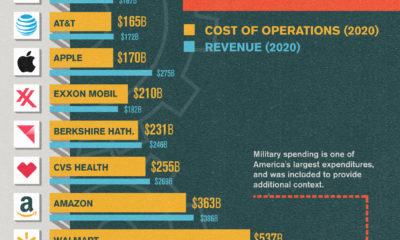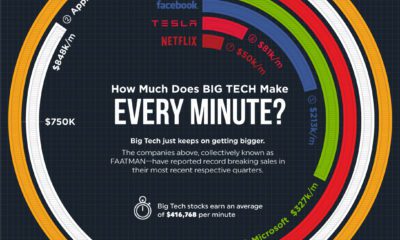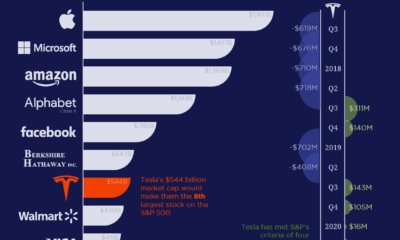The world’s largest companies have many similarities, but the size of their respective org charts is not necessarily one of them. At the one extreme, companies such as Walmart require a massive workforce in the millions to run retail operations around the globe. But at the other extreme, an energy giant like Valero is able to generate $76 billion of annual revenue with just 0.4% of the employees of Walmart. It raises the question: which types of companies make the most revenue per employee, and why?
Revenue Per Head
Today’s chart uses data on companies in the S&P 500 Index courtesy of analytics platform Craft.co. Instead of plotting the information for all 500 companies, we focused on two groups of firms: (1) energy companies, which tended to skew towards the upper end of revenue per employee ratio, and (2) brands that you will be familiar with, like Netflix, Walmart, Goldman Sachs, Ford, or IBM. The end result is an astonishing range, with companies making anywhere between <$100,000 per employee (Accenture, McDonald’s, Starbucks, Marriott) all the way to >$7 million per employee (Valero Energy).
Industry Averages
Here’s a look at this same data expressed as averages at an industry level, based on the sub-sectors that make up the S&P 500:
Interestingly, there is even a wide variance between sectors. Oil and gas companies make at least twice as much revenue per employee than the companies in all other sectors, while healthcare and utilities companies also have high ratios as well. There is a plausible explanation for this large discrepancy, and it has to do with the cost of doing business. Oil and gas companies have to spend billions of dollars on capital expenditures to build and maintain plants and rigs, while paying extra taxes and royalties. Healthcare companies have to spend a lot on R&D to stay competitive, while utilities must maintain vast amounts of infrastructure. At the same time, all of these sectors generally hire very specialized employees like engineers or scientists, which cost more than average. on
#1: High Reliability
Nuclear power plants run 24/7 and are the most reliable source of sustainable energy. Nuclear electricity generation remains steady around the clock throughout the day, week, and year. Meanwhile, daily solar generation peaks in the afternoon when electricity demand is usually lower, and wind generation depends on wind speeds.As the use of variable solar and wind power increases globally, nuclear offers a stable and reliable backbone for a clean electricity grid.
#2: Clean Electricity
Nuclear reactors use fission to generate electricity without any greenhouse gas (GHG) emissions.Consequently, nuclear power is the cleanest energy source on a lifecycle basis, measured in CO2-equivalent emissions per gigawatt-hour (GWh) of electricity produced by a power plant over its lifetime. The lifecycle emissions from a typical nuclear power plant are 273 times lower than coal and 163 times lower than natural gas. Furthermore, nuclear is relatively less resource-intensive, allowing for lower supply chain emissions than wind and solar plants.
#3: Stable Affordability
Although nuclear plants can be expensive to build, they are cost-competitive in the long run. Most nuclear plants have an initial lifetime of around 40 years, after which they can continue operating with approved lifetime extensions. Nuclear plants with lifetime extensions are the cheapest sources of electricity in the United States, and 88 of the country’s 92 reactors have received approvals for 20-year extensions. Additionally, according to the World Nuclear Association, nuclear plants are relatively less susceptible to fuel price volatility than natural gas plants, allowing for stable costs of electricity generation.
#4: Energy Efficiency
Nuclear’s high energy return on investment (EROI) exemplifies its exceptional efficiency. EROI measures how many units of energy are returned for every unit invested in building and running a power plant, over its lifetime. According to a 2018 study by Weissbach et al., nuclear’s EROI is 75 units, making it the most efficient energy source by some distance, with hydropower ranking second at 35 units.
#5: Sustainable Innovation
New, advanced reactor designs are bypassing many of the difficulties faced by traditional nuclear plants, making nuclear power more accessible.
Small Modular Reactors (SMRs) are much smaller than conventional reactors and are modular—meaning that their components can be transported and assembled in different locations. Microreactors are smaller than SMRs and are designed to provide electricity in remote and small market areas. They can also serve as backup power sources during emergencies.
These reactor designs offer several advantages, including lower initial capital costs, portability, and increased scalability.
A Nuclear-Powered Future
Nuclear power is making a remarkable comeback as countries work to achieve climate goals and ultimately, a state of energy utopia. Besides the 423 reactors in operation worldwide, another 56 reactors are under construction, and at least 69 more are planned for construction. Some nations, like Japan, have also reversed their attitudes toward nuclear power, embracing it as a clean and reliable energy source for the future. CanAlaska is a leading exploration company in the Athabasca Basin, the Earth’s richest uranium depository. Click here to learn more now. In part 3 of the Road to Energy Utopia series, we explore the unique properties of uranium, the fuel that powers nuclear reactors.



























